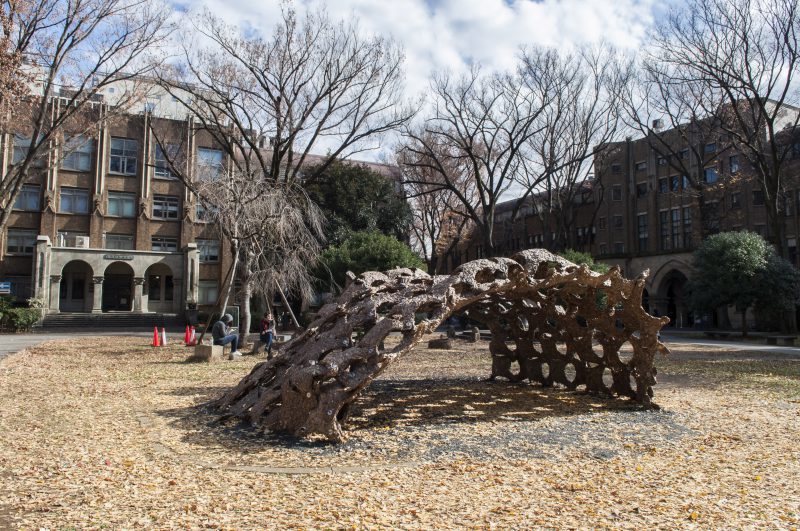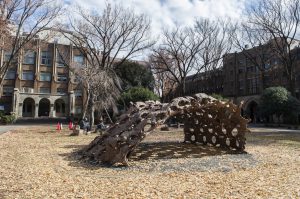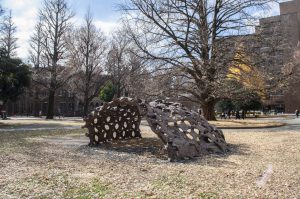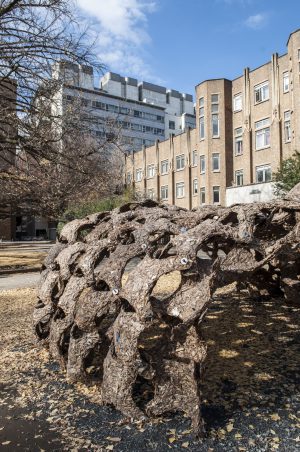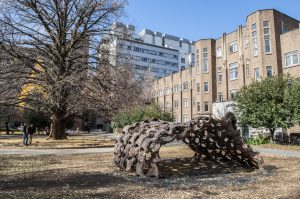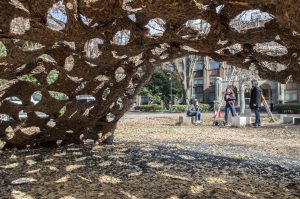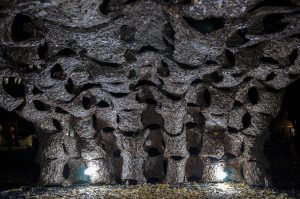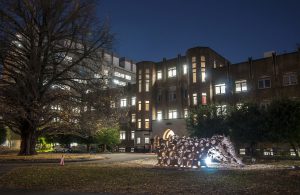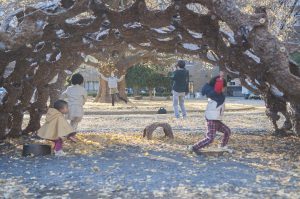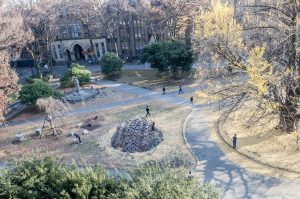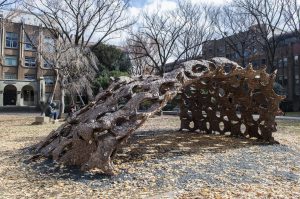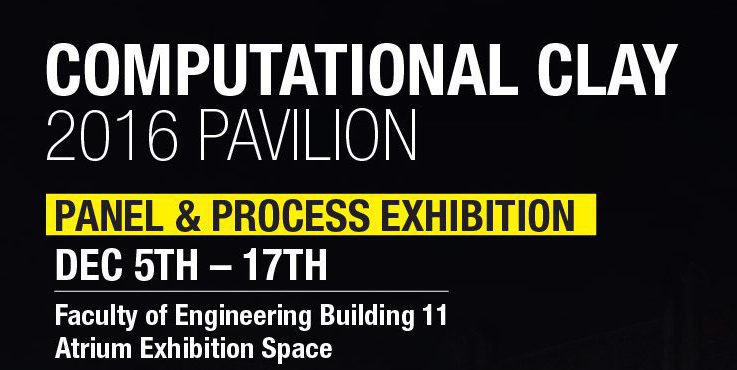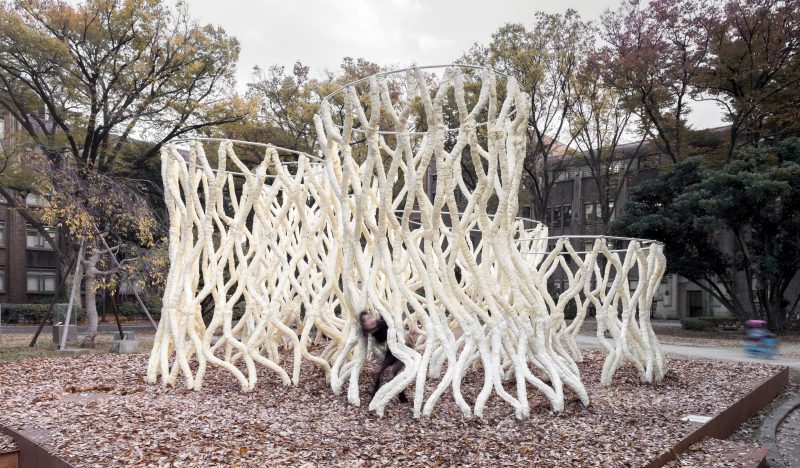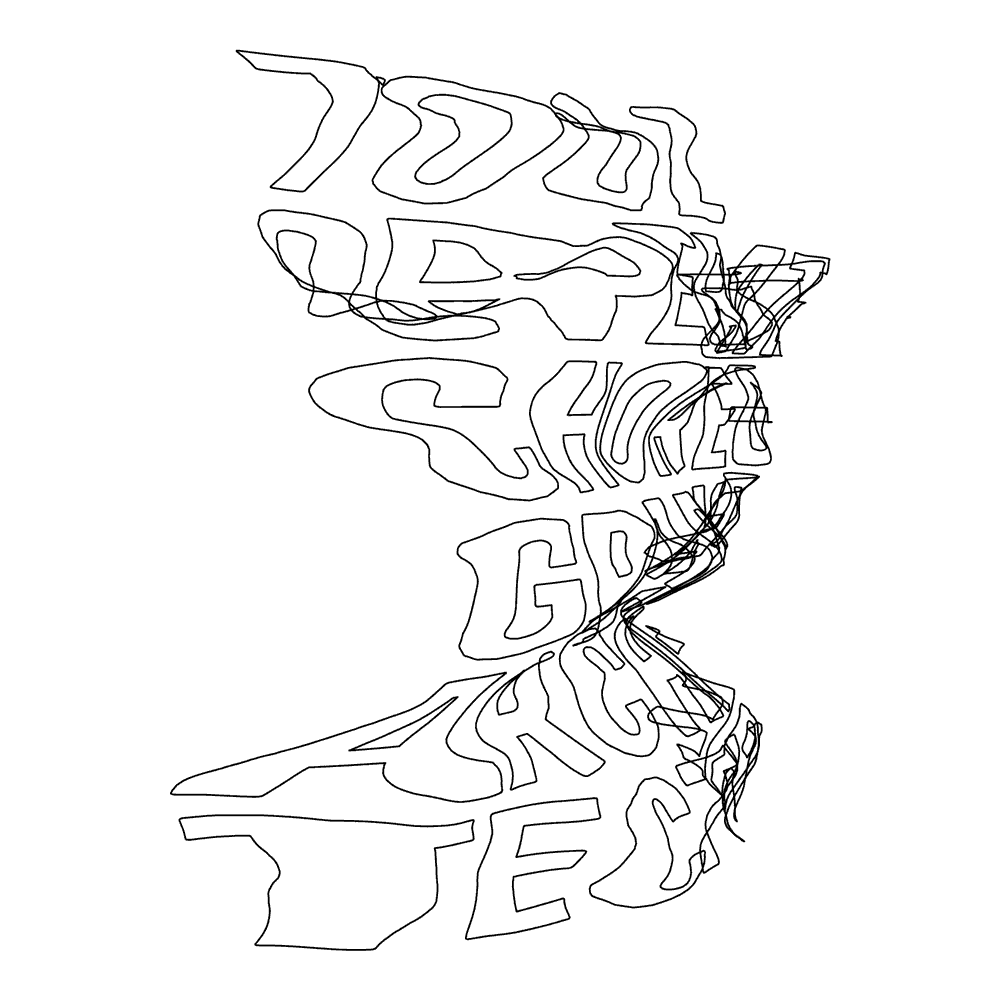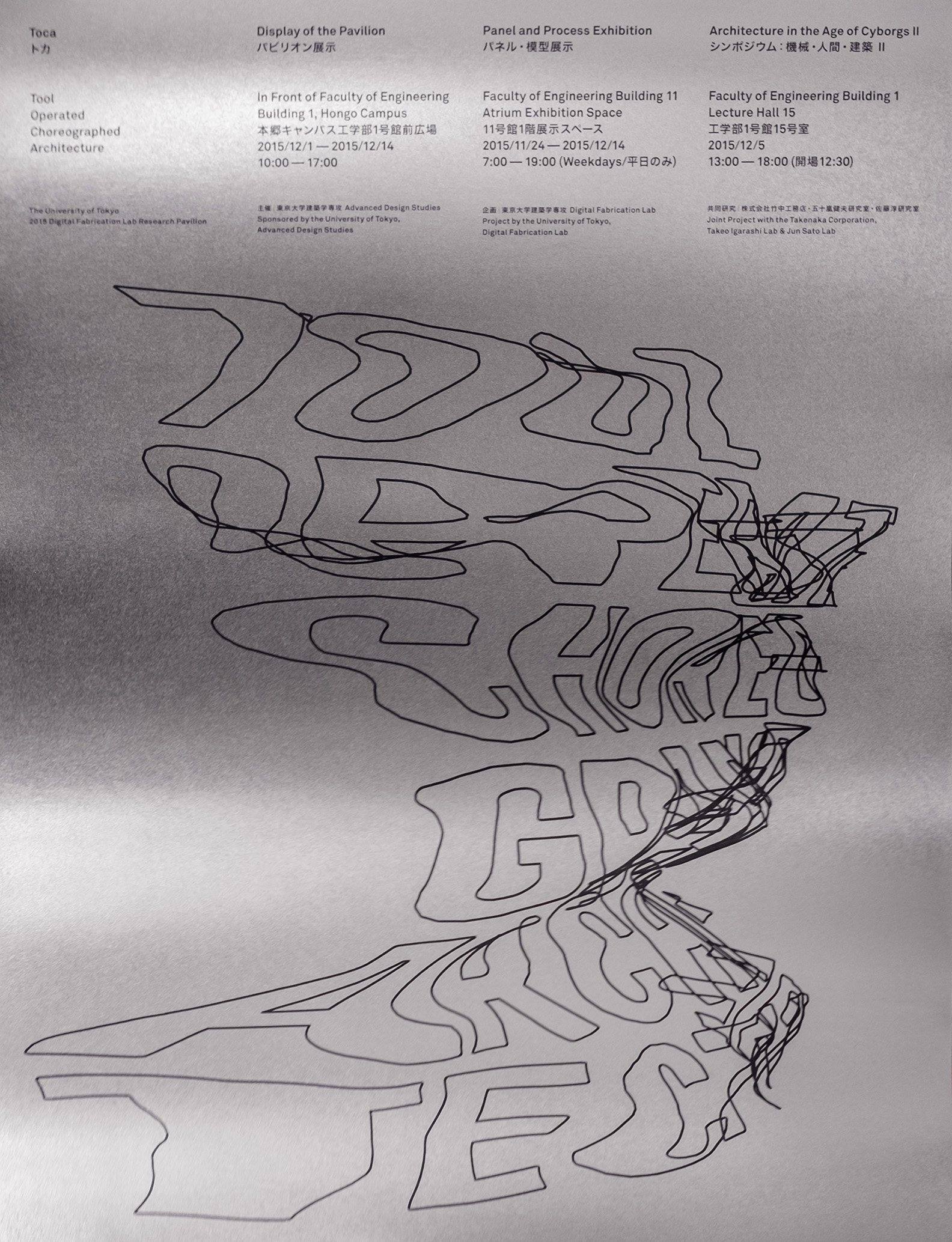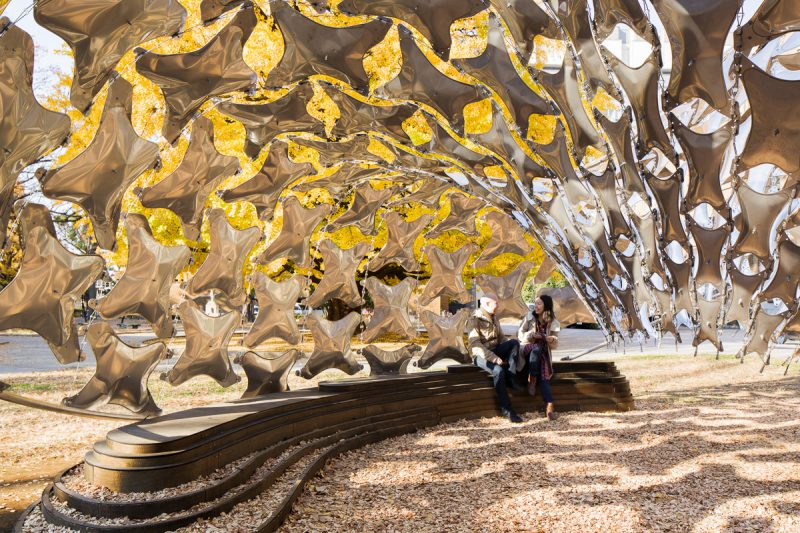東京大学建築学専攻Digital Fabrication Lab(DFL)では、建築施工におけるデジタル技術の活用をテーマに、毎年実験的なパビリオンを制作しています。単に技術による自動化や高度化を目指すのではなく、そこに「人間が関わること」の可能性を探る実証の場として、これまで「人間と機械が融合した3Dプリンター」(2014年STIKパビリオン)や「巨大3Dペン」(2015年TOCAパビリオン)を建築スケールで再現してきました。
本年Computational Clayプロジェクトでは「人間が関わること」をより一層推し進め、個性としての身体パフォーマンスを建築表現に反映させるため、人の動きと素材と関係に着目したユニークなパネル加工システムを開発しました。
Every year in the University of Tokyo’s Digital Fabrication Lab (DFL), digital fabrication technologies are used to produce an experimental pavilion project. The aim, rather than being simply to achieve automation or precision through use of such technologies, is to explore the potentials for human and machine collaboration. Past projects have focused on fusions between humans and machines through the use of 3D printers: the 2014 STIK Pavilion explored this theme through guided aggregation, and the 2015 TOCA Pavilion by using humans as a parameter along with an oversized 3D pen.
This year, in the Computational Clay Pavilion, we advance the role of the human in construction one step further, examining how an individual’s capabilities and performance can be expressed in an architectural output. We have developed a unique panelized construction system wherein the movements of humans and their relationship to the material are explored.
Project Credits:
主催: 東京大学建築学専攻 Advanced Design Studies(T—ADS) PRODUCED BY: Advanced Design Studies, Department of Architecture, The University of Tokyo
企画: 東京大学建築学専攻 Digital Fabrication Lab(DFL) 鹿島建設株式会社 東京大学大学院情報理工学系研究科コンピュータ科学専攻 五十嵐健夫研究室 東京大学大学院新領域創成科学研究科社会文化環境学専攻 佐藤淳研究室 素材協力: 株式会社エコグリーン、株式会社東邦アーステック(順不同)
PLANNING: Digital Fabrication Lab (DFL), Department of Architecture, The University of Tokyo
IN COLLABORATION WITH: Kajima Corporation Graduate School of Information Science and Technology, Department of Computer Science, Takeo Igarashi Laboratory Graduate School of Frontier Sciences, Department Socio-cultural Environmental Studies, Jun Sato Laboratory MATERIALS PROVIDED BY: Eco Green, Toho EarthTech (in random order)
UNIVERSITY OF TOKYO DIRECTING PROFESSORS Yusuke Obuchi (Associate Professor), Department of Architecture Jun Sato (Professor), Department of Frontier Sciences Takeo Igarashi (Professor), Department of Computer Science
UNIVERSITY OF TOKYO PROJECT MANAGEMENT Kensuke Hotta Shohei Furuichi Kosuke Nagata Shuta Takagi Shuntaro Nozawa Iris Zhang Déborah Lopez Lobato Hadin Charbel Haoran Xie
SECOND YEAR STUDENT TEAM Alric Lee Isaac Yoo Ittidej Lirapirom Luca Marulli Moritz Münzenmaier Pan Kalin Victor Hugo Wido
FIRST YEAR STUDENT TEAM Hirokazu Nakano Tei Mika Kaibara Portugaise Nathália Barros Abate Rotelli Rūta Stankevičiūte Tom Moss Tyler Timothy McBeth Veronika Smetanina Xiaoke Chen Yang Ao Ziyi Wu
ADDITIONAL SUPPORT Emi Shiraishi Federico Cazzaniga
PHOTOGRAPHS Toshihiko Kiuchi (Assistant Professor, University of Tokyo)
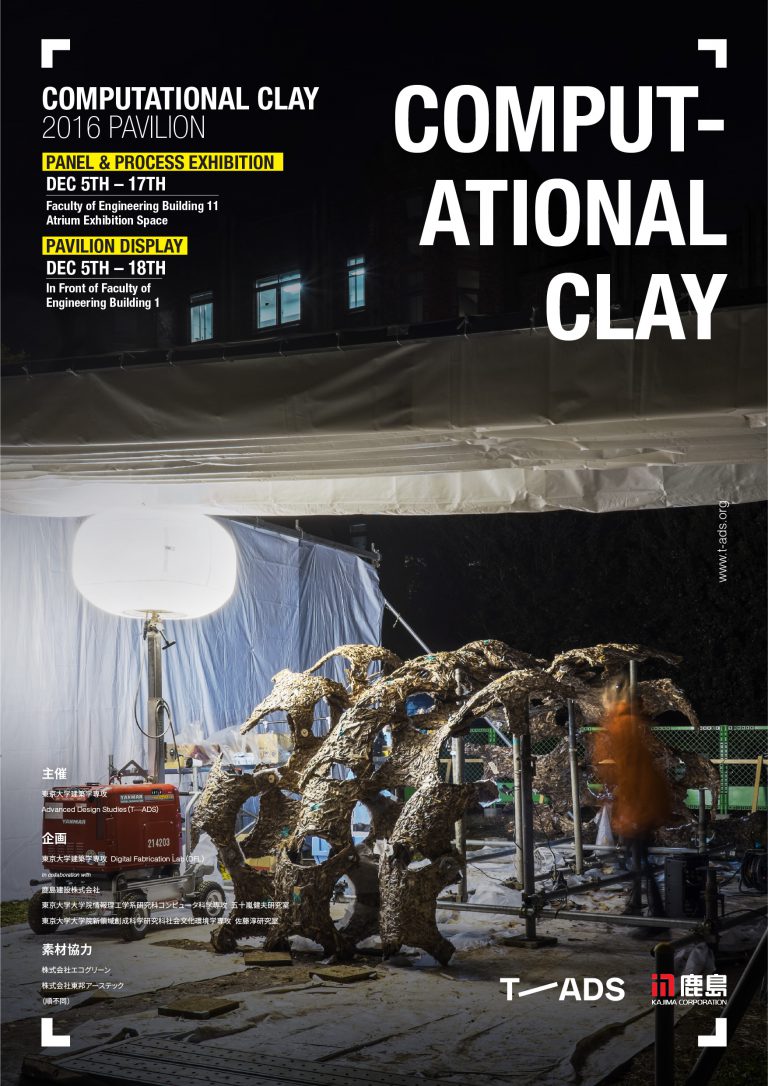
パビリオン公開 // PAVILION DISPLAY 12月5日(月)– 12月18日(日)// December 5 (Mon) – December 18 (Sun) 10:00 – 17:00
東京大学本郷キャンパス工学部1号館前広場 The University of Tokyo, Hongo Campus, Engineering Building #1 Plaza
パネル・模型展示 // PANEL AND PROCESS EXHIBITION 12月5日(月)– 12月17日(土)// December 5 (Mon) – December 17 (Sat) 平日と土曜日のみ // Weekdays and Saturdays only 07:00 – 18:00 (12月5日は13:00から) // (Open at 13:00 on December 5) 東京大学本郷キャンパス工学部 11 号館1階展示スペース(入場無料) The University of Tokyo Hongo Campus, Engineering Building #11, 1F Exhibition Space (free entry)
主催: 東京大学建築学専攻 Advanced Design Studies(T—ADS) PRODUCED BY: Advanced Design Studies, Department of Architecture, The University of Tokyo
企画: 東京大学建築学専攻 Digital Fabrication Lab(DFL) 鹿島建設株式会社 東京大学大学院情報理工学系研究科コンピュータ科学専攻 五十嵐健夫研究室 東京大学大学院新領域創成科学研究科社会文化環境学専攻 佐藤淳研究室 素材協力: 株式会社エコグリーン、株式会社東邦アーステック(順不同)
PLANNING: Digital Fabrication Lab (DFL), Department of Architecture, The University of Tokyo
IN COLLABORATION WITH: Kajima Corporation Graduate School of Information Science and Technology, Department of Computer Science, Takeo Igarashi Laboratory Graduate School of Frontier Sciences, Department Socio-cultural Environmental Studies, Jun Sato Laboratory MATERIALS PROVIDED BY: Eco Green, Toho EarthTech (in random order)
東京大学建築学専攻Digital Fabrication Lab(DFL)では、建築施工におけるデジタル技術の活用をテーマに、毎年実験的なパビリオンを制作しています。単に技術による自動化や高度化を目指すのではなく、そこに「人間が関わること」の可能性を探る実証の場として、これまで「人間と機械が融合した3Dプリンター」(2014年STIKパビリオン)や「巨大3Dペン」(2015年TOCAパビリオン)を建築スケールで再現してきました。
本年Computational Clayプロジェクトでは「人間が関わること」をより一層推し進め、個性としての身体パフォーマンスを建築表現に反映させるため、人の動きと素材と関係に着目したユニークなパネル加工システムを開発しました。
Every year in the University of Tokyo’s Digital Fabrication Lab (DFL), digital fabrication technologies are used to produce an experimental pavilion project. The aim, rather than being simply to achieve automation or precision through use of such technologies, is to explore the potentials for human and machine collaboration. Past projects have focused on fusions between humans and machines through the use of 3D printers: the 2014 STIK Pavilion explored this theme through guided aggregation, and the 2015 TOCA Pavilion by using humans as a parameter along with an oversized 3D pen.
This year, in the Computational Clay Pavilion, we advance the role of the human in construction one step further, examining how an individual’s capabilities and performance can be expressed in an architectural output. We have developed a unique panelized construction system wherein the movements of humans and their relationship to the material are explored.
The 2015 Digital Fabrication Lab project, TOCA (Tool Operated Choreographed Architecture) explored the potentials of human-machine collaboration in a manner that expanded on the knowledge acquired in the 2014 STIK Pavilion project. The research and development of the TOCA project sought to utilize the adaptability and creativity of humans, and combine it with the precision and efficiency of machinery. The resulting pavilion utilized a scanning and guiding system to support human users on-site, a material used to extrude components (foam), a handheld “smart” tool to dispense the material, and a geometric form which iteratively optimized through use of a feedback system that integrated human error. The pavilion project, which began with a digitally-defined target model, was constructed on-site by teams of users, who sprayed components by hand. The results of the work were scanned and analyzed, and an updated digital model was defined and indicated to users for the next layer of the project. In this manner, any “errors” introduced throughout the spraying process were integrated into subsequent construction steps. The final pavilion represents the accumulation and integration of these errors. The project was made possible through cross-disciplinary collaboration; structural engineering, architecture, and computer science laboratories contributed to realizing the technologies and the final output.
Project Credits
University of Tokyo Staff
Yusuke Obuchi (Associate Professor), Department of Architecture
Jun Sato (Professor), Department of Frontier Sciences
Takeo Igarashi (Professor), Department of Computer Science
Kaz Yoneda (Research Assistant), Department of Architecture
Kosuke Nagata (Technical Advisor), Computer Science
Kensuke Hotta (Course Assistant), Department of Architecture
Mika Araki (Researcher), Department of Frontier Sciences
Yosuke Takami (Technical Assistant), Department of Computer Science
Students
Gilang Arenza
Hadin Charbel
Ann-Kristin Crusius
Jiang Lai
Samuel Eugene Lalo
Deborah Lopez Lobato
Yuanfang Lu
Ratnar Sam
Pitchawut Virutamawongse
Ying Xu
Jan Vranovsky
Akane Imai
Pan Kalin
Yi Dong Alric Lee
Ittidej Lirapirom
Kenneth Larssen Lonning
Luca Maruli
Moritz Munzenmaier
Masatoshi Nishizato
Victor Hugo Wido
Christopher Wilkens
Li Xu
Isaac Sekjoon Yoo
Yihan Zhang
Sponsor
Takenaka
Photographer
Jan Vranovsky
The University of Tokyo Digital Fabrication Lab Pavilion 2015 TOCA (Tool Operated Choreographed Architecture)
|パビリオン展示| 日時:12月1日(火)〜12月14日(月) 10:00 – 17:00 場所:東京大学本郷キャンパス工学部1号館前広場
|パネル・模型展示| 日時:11月24日(火)〜12月14日(月) 7:00 – 18:00(平日のみ) 場所:東京大学本郷キャンパス工学部11号館1階展示スペース
|シンポジウム| 機械・人間・建築 Ⅱ Architecture in the Age of Cyborgs Ⅱ 日時:12月5日(土)13:00 – 18:00(開場12:30) 場所:東京大学工学部1号館15号講義室(定員100名先着順 入場無料) 趣旨:3Dプリンタやレーザーカッターなどのデジタル・ファブリケーション機器は、建築の生産と私たちの生活をどう変えるのか—— DFL(Digital Fabrication Lab)は毎年、建設会社と共同で、デジタル・ファブリケーションを応用した実験的パビリオンの建設を行っています。本年、竹中工務店と共同で行っているTOCA(Tool Operated Choreographed Architecture)プロジェクト(進行中)は、昨年に引き続き「人と機械の恊働」をテーマとし、「人が地面から建築を描き上げる3Dペン」による建築に挑みます。 昨年取り組んだ STIK(Smart Tool Integrated Konstruction)プロジェクトでは、あらかじめ決めた目標形状に向けて、デジタルの施工情報をプロジェクション・マッピングで作業者に伝えるシステムと、割り箸のような棒材を接着剤とともに送り出す手持ち工具を組み合わせ、「人と機械が融合した3Dプリンタ」による新しい建築表現を実現しました。今年のTOCAプロジェクトでは、目標形状を作業者に伝えることに加えて、人の作業による誤差をデジタル化して構造最適化をくり返すことで、目標形状自体を徐々に変化させることを試みます。これは、人と機械が恊働することにより、あらかじめ形状がデザインされていながら、人間的なゆらぎを柔軟に取り込み、実際の施工によってはじめてユニークに形状が確定する建設システムです。 シンポジウムでは、第一部で、DFLと共同研究した構造の佐藤淳研究室、コンピューター・サイエンスの五十嵐健夫研究室、そして竹中工務店とともにパビリオンTOCAの成果を報告します。第二部では、デジタル機械の建築への応用研究を推進しているスイス連邦工科大学チューリッヒ校(ETH-Z)教授のマティアス・コーラー氏を招き、国内で先進的な研究を行っている研究者の方々とともに、私たちがこれから考えるべき機械・人間・建築について議論を行います。 第一部(13:00 -): 小渕祐介(東京大学准教授)、米田カズ(東京大学小渕研究室)、五十嵐健夫(東京大学教授・コンピュータ科学専攻)、荒木美香(東京大学佐藤淳研究室・構造担当)、竹中工務店プロジェクトチーム 第二部(15:30 -): マティアス・コーラー(スイス連邦工科大学チューリッヒ校教授)、金田充弘(東京藝術大学准教授)、池田靖史(慶應義塾大学大学教授)、小林博人(慶應義塾大学教授) オープニングレセプション(18:00 – 19:00)参加無料
主催 東京大学建築学専攻 Advanced Design Studies(T_ADS) 企画 東京大学建築学専攻 Digital Fabrication Lab(DFL) 共同研究 株式会社竹中工務店 東京大学大学院情報理工学系研究科コンピュータ科学専攻 五十嵐健夫研究室 東京大学工学系研究科建築学専攻 佐藤淳研究室 研究協力 株式会社エービーシー商会 太陽金網株式会社 マーキュリー・サプライ・システムス株式会社 デミレックジャパン株式会社 圓井繊維機械株式会社 サンエム工業株式会社 (順不同)
Display of the Pavilion In Front of Faculty of Engineering Building 1, Hongo Campus 2015/12/1 — 2015/12/14 10:00 – 17:00
Panel and Process Exhibition Faculty of Engineering Building 11 Atrium Exhibition Space 2015/11/24 — 2015/12/14 7:00 – 19:00 (Weekdays)
Symposium : Architecture in the Age of Cyborgs Ⅱ Faculty of Engineering Building 1 Lecture Hall 15 2015/12/5 13:00 — 18:00 (Opens from 12:30) Session 1 (13:00 – ) – Yusuke Obuchi (The University of Tokyo) – Kaz Yoneda (The University of Tokyo) – Takeo Igarashi (The University of Tokyo, Computer Science) – Mika Araki (The University of Tokyo, Structure Engineering) – TAKENAKA Project Team Session 2 (15:30 – ) – Matthias Kohler (ETH-Z) – Mitsuhiro Kanada (Tokyo University of the Arts) – Yasushi Ikeda (Keio University) – Hiroto Kobayashi (Keio University) Opening Reception 18:00 – 19:00
Digital Fabrication Lab Pavilion, 2013
Design Team:
The University of Tokyo teaching staff: Yusuke Obuchi, Toshikatsu Kiuchi, So Sugita, Hironori Yoshida
The University of Tokyo students: Christopher Sjoberg, Yeonsang Shin, Miguel Puig, Zhang Ye, Ana Luisa Soares, Ma Sushuang, Tong Shan, Andrea Trajkovska, Quangtuan Ta, Wei Wang, Anders Rod, Benjamin Berwick, Qiaomu Jin, Fawad Osman, Yanli Xiong, Andrea Bagniewski, Kevin Clement, Ornchuma Saraya, Minjie Xu
Obayashi Corporation: Tomoo Yamamoto, Kenichi Misu, Gendai Ono, Yasuo Ichii, Keisuke Fujiwara, Shunsuke Niwa, Tatsuji Kimura, Masaru Emura, Taiki Byakuno, Takahide Okamoto
Structural engineer: Jun Sato
Fabrication of components: Tsukasa Takenaka (AnS Studio)
Construction: Multibuilder
Fabrication: Togari Kogyo
Structure: Freeform Surface Tensegrity Structure
Specifications:
Compressive components: stainless steel plates with 0.5 mm / 0.8 mm / 1.2 mm / 1.5 mm thickness
Tension cables: stainless steel cables in 3 mm diameter
Base ring: stainless steel pipe in 48mm diameter
Foundation: precast concrete blocks
Furniture: painted plywood
Weight: 1.5 t (upper structure in stainless steel), 1 t (concrete foundation)
Design Phase: October 2012 – March 2013
Design development, fabrication & construction: April – November 2013
Completion date: 24 November 2013

